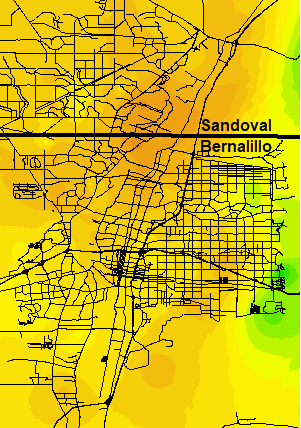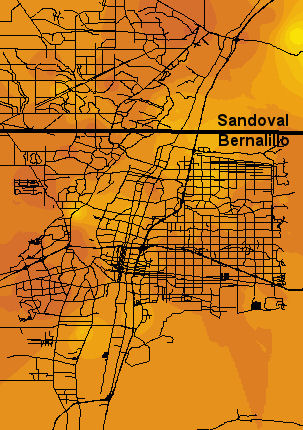
|
Just when it was looking bleak, the end of September came and saved the monsoon. Alright, that may be a little dramatic, but the last four days of September provided more precipitation than all of August and June combined, and actually tipped the scales at the Sunport to an above normal monsoon.
The maps below show the spatial distribution of monsoonal precipitation across Albuquerque for various years. Precipitation totals encompass the dates of June 15th through September 30th. Since the only official stations are the Albuquerque Sunport and a handful of cooperative observers, these maps could only be possible thanks to the dedicated members of the Community Collaborative Rain, Hail and Snow (CoCoRaHS) Network. These volunteer observers help fill in the data gaps across Albuquerque, Rio Rancho, Corrales and Placitas. However, there are still many areas in southwest Albuquerque that are not represented well due to a lack of observations. If you want to be a CoCoRaHS observer, please visit the CoCoRaHS webpage!
|
||||||||||||||||||||||||||||||||||||||||||
| The map below represents the 2017 Monsoon precipitation totals across the metro area. Most reporting stations received between 3 and 7 inches of rainfall, though there were a few spots that received a little more! Again, these totals would have been at least an inch or two lower without the last few days of September. | ||||||||||||||||||||||||||||||||||||||||||
 |
Key
 |
|||||||||||||||||||||||||||||||||||||||||
| 2017 | ||||||||||||||||||||||||||||||||||||||||||
|
We did better than last year! Almost all areas, except across portions of southeast Albuquerque, received around 2 inches more rainfall than the 2016 Monsoon. This was definitely good news, but it didn't look so good until the end of September. Until then, it was looking quite a bit like 2016. The highest rainfall totals this season were along the foothills, around Four Hills, and portions of the northeast heights. These latter two areas benefitted from heavy rainfall that fell on the night of July 17th. Flash flooding occurred along Academy Road when up to 1.80 inches of rain fell in one hour's time. This same night, around an inch of rain fell over the Four Hills area, though flash flooding did not occur. The area north of Four Hills received good rainfall again on August 4th, when between 0.75 and 1.5 inches of rain fell. August was extremely disappointing, rainfall-wise, across Rio Rancho. Most areas received less than an inch of rain. September nicely made up for it though. Between 1.5 and 2.5 inches of rainfall occurred, not just across Rio Rancho, but much of Albuquerque. For the monsoon as a whole, Corrales seems to be the area that missed out. Around three inches of rainfall was common in this area, which were certainly the lowest totals in the metro area. |
||||||||||||||||||||||||||||||||||||||||||
 |
In 2016, 3.09 inches of rain fell at the Albuquerque Sunport. This is almost two inches shy of the 2015 total and is also well below climatological normals. Not all locations across Albuquerque saw this kind of paltry precipitation, but there were some, and they were scattered across the metro. Some of the obvious areas that saw these lower precipitation totals included portions of the northeast heights and western Rio Rancho. Meanwhile, the light green splotch across the southeast side of Albuquerque north of Four Hills shows where the biggest precipitation totals were this year. Though the seasonal total was above 5.5 inches, between 2 and 2.5 inches of that fell on August 4th, when very heavy rain fell for almost two hours. Fortunately, no significant flooding was observed with those storms. Nearly two inches of rain fell on portions of northwest Albuquerque and portions of southern Rio Rancho during the early evening of July 29th. Then the following day, over an inch of rain fell across south central Albuquerque, near and just south and east of UNM. The intersection at Silver and Yale as well as the Lomas and Carlisle intersection were closed due to flooding on July 30th. |
|||||||||||||||||||||||||||||||||||||||||
| 2016 | ||||||||||||||||||||||||||||||||||||||||||
 |
In 2015, most areas saw above normal precipitation. Wetter parts of the Metro included the westside as well as portions of the foothills. Most areas along and west of the Rio Grande in Bernalillo County received between 5.5 and 7.5 inches of rain as did the foothills. Rio Rancho was among the driest area in the metro with most locales reporting less than 5 inches of rain. |
|||||||||||||||||||||||||||||||||||||||||
| 2015 | ||||||||||||||||||||||||||||||||||||||||||
 |
Precipitation amounts for 2014 were very similar to 2015, but different areas saw the greater amounts. Wetter parts of the Albuquerque Metro in 2014 were the UNM area, which was due to between 2.50 and 2.80 inches of rain falling in a two hour period on the night of August 1st. Season totals for the UNM area were between 6 and 7 inches of rain. The foothills were again one of the wetter spots, but interestingly, Rio Rancho was again one of the driest areas. |
|||||||||||||||||||||||||||||||||||||||||
| 2014 | ||||||||||||||||||||||||||||||||||||||||||
 |
Using the same scale as above, it is easy to see that the 2013 Monsoon was a wet one. Everyone in the metro area received over 5 inches of rain, and some areas received over 10! The rain was a welcome sight for many, though in most cases, the rain came faster than what soils could absorb. The enhanced area of precipitation totals, ranging from 10 to 12 inches across the northeast heights, largely stemmed from the back-to-back thunderstorm events on July 26th, where some calendar day totals exceeded 4 to 5 inches. Perhaps more notably, was the week-long stretch of rainfall in September, which accounted for almost half of Albuquerque's Monsoon precipitation. For the Albuquerque Sunport, 3.14 inches of rain was recorded during these 7 days, though some areas in the Foothills and in Rio Rancho received over 5 inches! Even only using the 3.14 inches at the official station, this was the wettest 7-day stretch since June 1933! |
|||||||||||||||||||||||||||||||||||||||||
| 2013 | ||||||||||||||||||||||||||||||||||||||||||
 |
Just five years ago, we thought it would never rain again. Ok, that's a bit dramatic, but we were desperate for rainfall. In fact, you'll notice that for many areas, the week-long stretch mentioned above in 2013 provided more rainfall than all of the 2012 Monsoon Season for most of the metro area. In 2012, the Albuquerque Sunport received 3.36 inches for the entire season. Going back even further, in 2011 the Albuquerque Sunport measured only 1.72 inches. 2011 was the 5th driest Monsoon Season on record. What a difference a few years makes! |
|||||||||||||||||||||||||||||||||||||||||
| 2012 | ||||||||||||||||||||||||||||||||||||||||||
 |
Many people wondered if the 2013 totals would reach the totals from 2006. Though close, they didn't quite get there. The map to the left shows the precipitation distribution across the metro area from 2006 using the same scale as above. 2006 still ranks as the wettest Monsoon on record, with 9.42 inches measured at the Albuquerque Sunport. |
|||||||||||||||||||||||||||||||||||||||||
| 2006 | ||||||||||||||||||||||||||||||||||||||||||
| Some more statistics... | ||||||||||||||||||||||||||||||||||||||||||
|
The biggest calendar day rain total during the 2017 Monsoon at the Sunport was 0.80 inches on September 27th closely followed by the day after with 0.78 inches. Following behind these days, the highest calendar day totals included 0.48 inches on June 26th, 0.46 inches on August 29th, and 0.44 inches on September 30th. Rain seemed to like the end of each month this year. |
||||||||||||||||||||||||||||||||||||||||||
| The precipitation total for the four days at the end of September was 2.10 inches, or approximately 42% of the precipitation that fell this monsoon. That's right, almost half of this year's monsoon rainfall in just four days! And not just four days, four consecutive days, at the end of the season! Normal monsoon rainfall in Albuquerque totals 4.61 inches. The 2017 total of 5.02 inches at the Sunport is 109% of normal. This is nearly two inches above what the Sunport received in 2016! Though, in 2016, the Sunport was one of the driest areas of the metro. | ||||||||||||||||||||||||||||||||||||||||||
| The Albuquerque Valley received 6.19 inches of rain this season. Last year, only 4.14 inches of rain was recorded. Normal rainfall for the valley during the monsoon is 4.78 inches. The Albuquerque Foothills received 7.21 inches of rain this year. Last year, the foothills received approximately 5.72 inches. Normal precipitation for the June 15 through September 30th period is 7.23 inches. Comparing these totals to 2006, the Albuquerque Foothills received 16.65 inches of precipitation while the Albuquerque Valley 8.99 inches. | ||||||||||||||||||||||||||||||||||||||||||
| Here are the top 5 wettest and driest Monsoon's on record. | ||||||||||||||||||||||||||||||||||||||||||
|
||||||||||||||||||||||||||||||||||||||||||